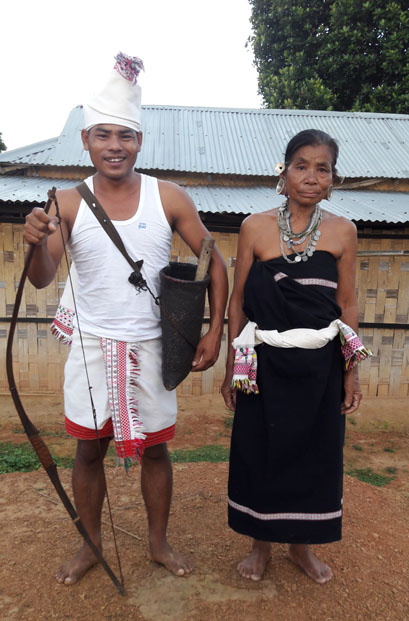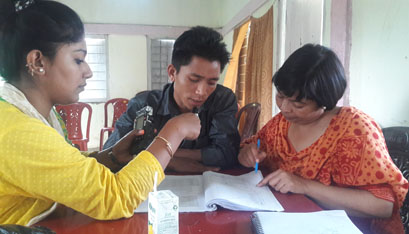

Name of the language: Khelma
Alternate Name: Sakachep
Classification: Unclassified Tibeto-Burman Languages
Code: 003_Khe/A_CFEL_TU_2016
Places/ region spoken at: The study is based on the data collected during six field trips conducted among ten Khelma villages viz. Kekrangsip, New Kekrangsip, Tuisnanthuan, Tuijonte, Dorbin, Langlut(H), Langlut(Ch), Bangphiri(H), Bangphiri(Ch), and Baigaon of the Khelma speech communities that come under New Sangbar Community Development Block, under Umrangso sub-division of Dima Hasao district, Assam. It must be mentioned that except in Dima Hasao, Khelma is known as Sakachep in Cachar, Karbi Anglong, Hailaknadi and Karimganj districts of Assam and the neighbouring states like Mizoram, Meghalaya, Tripura and Nagaland of India.
Language Status: Vulnerable
Language Resource: Centre for Endangered Languages, Tezpur University.
Khelma (or, Sakachep) is the language of the Khelmas, one of the smallest ethnic groups of the Old Kuki community in North-East India, and they mainly inhabit in the areas of the districts of Dima Hasao, Cachar, Karbi Anglong, Hailakandi, and Karimganj of Assam. The term Khemla is believed to be a British invention when they administered the North Cachar Hills, the Cachar and the Karbi Anglong districts of Assam and the Jaintia hills of Meghalaya. The name Khelma is recognized only in the Dima Hasao district of Assam. In other districts of Assam and the neighbouring states of Manipur, Mizoram, Meghalaya, Nagaland, and Tripura, the community is known as the Sakachep community. According to the SIL Ethnologue (2003), the total population of this community is approximately 25,000 in the entire NE region. Khelma, a Sino-Tibetan language is an unclassified language. During the three field trips conducted by staff of the Centre, a total number of ten Khelma villages were covered. These villages come under the New Sangbar Community Development Block of the Umrangso Circle, Dima Hasao, Assam. The names of the villages and the total population of each of them are as follows (population shown within bracktes): Baigaon (154); Bangphri (Ch) (183); Bangphri (H) (159); Dorbin (183); Kekrangsip (98); Tuisnanthuon (38); Tuizonte (146); Langlut (H) (64); Langlut (Ch) (239); and New Kekrangsip (21). These villages are located at different distances from the Umrangso town (the distances are shown in brackets): Bangphri (Ch) (30); Bangphri (H) (21); Dorbin (10); Kekrangsip (18); Tuisnanthuon (10); Tuizonte (30); Langlut (H) (32); Langlut (Ch) (28); and New Kekrangsip (13).
The natives of Khelma are well versed in the dominant languages, spoken around them, i.e. Dimasa, Karbi, Nepali, Biate Hmar, Mizo, and Haflong Hindi. Few can speak English also. Khelma is spoken at home domain and the dominant languages are spoken outside the home domain. The status of Khelma is vulnerable (Level 4) according to the UNESCO's scales of language endangerment in terms of intergenerational transmission. The Khelmas practice both settled and shifting forms of cultivation. The agricultural produce includes rice, maize, yam, ginger, turmeric, chillies, vegetables, cotton etc. More than 60% of the population is presently involved, in one way or the other, in agriculture and sericulture. A handful of the Khelmas are engaged in the government sector and some have opted for small-scale business such as carpentry, poultry and cattle rearing. The literacy rate of the Khelma community which comes under the New Sangbar Community Development Block of the Umrangso Circle, Dima Hasao, Assam is 46.15%. 18.98% of this is the literacy rate of the women. Traditionally, the Khelma community practiced a fusion of naturalism and animism; then they followed the Hindu religion but later converted to Christianity. However, in some cases, traditional influences are found interwoven with Christian beliefs and practices.
Data collected from the 3 field trips:
2000 lexical items; 800 sentences; 4 folk tales; 2 lullabies. Word sound segmentation and phoneme inventory are completed. Analysis of the tonal system, the morphology and the syntax is in process.

Khelma traditional dress

Research Associate & Field Assistant with an Informants